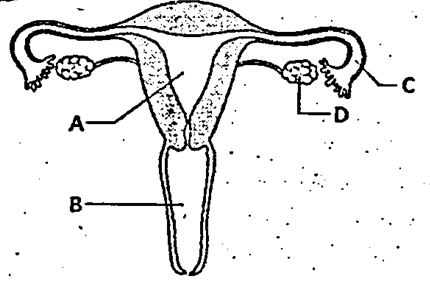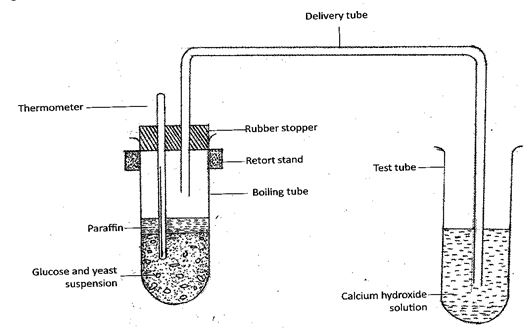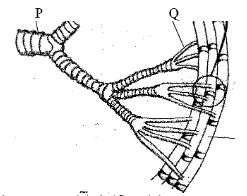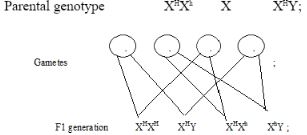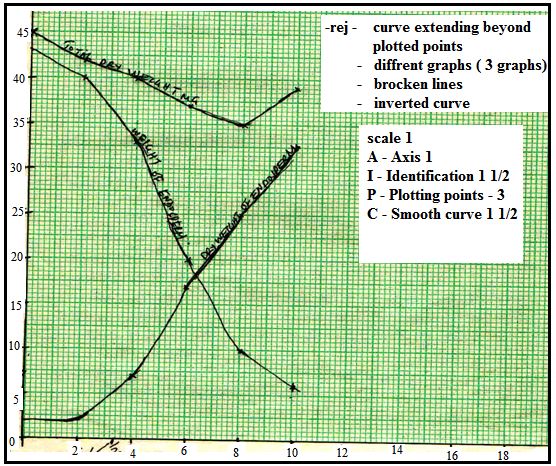INSTRUCTIONS TO CANDIDATES:
- Answer ALL the questions
Answers should be written in the spaces provided
- The flow diagram below represents passage of a meal through the human digestive system. Study the diagram and answer the questions that follow.
- Name the physical process that will occur in mouth cavity (1mk)
- Name the digestive juices B and C(2mks)
B
C - Explain two ways in which the digestive system is protected from corrosive effects of digestive juices.(2mks)
- Name the hormone that stimulate secretion of juice B.(1mk)
- Identify two contents of digestive juice A (2mks)
-
- The following diagrams represent human sex cells.
- Name the cell B (1mk)
- Give one feature of cell A which makes it different from cell B.(1mk)
- The diagram below represents the female reproductive system
- Name the part marked A.(1mk)
- State the role of the part marked D(1mk)
- State two functions of amniotic fluid.(2mks)
-
- Name the organism that causes syphilis(1mk)
- State one symptom of primary syphilis(1mk)
- The following diagrams represent human sex cells.
- The set up below illustrates an experiment to demonstrate a certain biological process, before the addition of the yeast suspension the glucose solution was first boiled and then cooled at 40oC.
- What was the aim of the experiment?(1mk)
- What observations would you make in the tubes a few minutes after the experiment begun(2mks)
- Explain the observations made in (b) above(2mks)
- Why was glucose solution boiled before cooling at 40oC(1mk)
- How can you set up a control experiment for the above (1mk)
-
- What is meant by the term linked genes? (1mk)
- Haemophilia is a genetic condition transmitted through a recessive gene linked to X chromosome. The normal gene may be represented by XH.
- What is the genotype of a haemophilic female?(1mk)
- A woman who is a carrier for the haemophilia gene marries a normal man. Work out the phenotypic ratio for their offspring. (4mks)
- Haemophilia is more common in males than in females. Explain this phenomenon.(2mks)
-
- What is meant by the following terms. Give an example in each case.
- Homologous structures(1mk)
Example - Analogous structures(1mk)
Example - Vestigial structures(1mk)
Example
- Homologous structures(1mk)
- The diagram below represents part of a gaseous system in a grasshopper.
- Name the structures labeled P and Q
P(1mk)
Q(1mk) - State the function of the structure labeled P(1mk)
- Describe the path taken by carbon (IV) oxide from the tissues of the insect the atmosphere (3mks)
- How is the structure labeled Q adapted to its functions(2mks)
- Name the structures labeled P and Q
- What is meant by the following terms. Give an example in each case.
SECTION B
Answer question 6(compulsory) in the spaces provided and either question 7 or 8 in the spaces provided after 8.
- During germination and growth of a cereal, the dry weight of endosperm, the embryo and the total dry weight were determined at two day intervals. The results are shown in the table below:
Time after planting (days) Dry weight of endosperm (mg) Dry weight of embryo (mg) Total dry weight (mg) 0 43 2 45 2 40 2 42 4 33 7 40 6 20 17 37 8 10 25 35 10 6 33 39 - Using the same axes, draw graphs of dry weight of endosperm, embryo and the total dry weight against time.(7mks)
- What was the total dry weight on day 5(1mk)
- Account for
- Decrease in dry weight of endosperm from 0 to 10 (2mks)
- Increase in dry weight of embryo from day 0 to day 10 (2mks)
- Decrease in total dry weight from day 0 to day 8 (1mk)
- Increase in total dry weight after day 8 (1mk)
- State two factors within the seed and two outside the seed that cause dormancy
- Within the seed.(2mks)
- Outside the seed (2mks)
- Give two characteristics of meristematic cells(2mks)
-
- Define:
- Transpiration (2mks)
- Translocation(2mks)
- Identify and explain five structural factors that affects the rate of transpiration in plants.(16mks)
- Define:
- Discuss evidences that support organic evolution.(20mks)

MARKING SCHEME
-
- Mastication;/chewing;/grinding; any one (1mk)
- B – Gastric juice; (1mk)
C – Intestinal juice;/ succus entericus; ( reject wrong spelling - produces mucus;
Enzymes produced in inactive from that is pepsinogen and trypsinogen (2mks) - Gastrin;
- Enzyme salivary amylase, Ptyalin;
Mucin/Mucus;
Water; (any two) (2mks)
-
-
- Ovum
- Cell A has a tail unlike B
Cell A has mitochondrion sheath unlike cell B
Cell A is tadpole in shape while cell B is circular in shape
-
- uterine cavity
- Site for ova formation
Secretion of oestrogen and progesterone
- Acts as shock absorber protecting the foetus from external mechanical damage
Provides fluid medium that suspends the foetus allowing it to move and grow freely -
- TreponemaPallidum
- painless ulcers on genitals or mucous membrane.
-
-
- To show that carbon (IV) oxide is produced during anaerobic respiration. (1mk)
- There is production of bubbles in the boiling tube of carbon (IV) oxide leading to the formation of a white precipitate in the test tube containing calcium hydroxide solution.(2mks)
- Yeast cells undergo anaerobic respiration prodicing carbon (IV0 oxide gas which dissolves in calcium hydroxide solution forming a white precipitate; production of the gas results in bubbles
- To kill other micro-organisms present in glucose solution thus eliminating microbial respiration
- Through the use of glucose solution without yeast cells
-
- Genes located on the same chromosome and are always transmitted together;
-
- XhXh ;
Phenotypic ratio 3 normal: 1 haemophiliac;- Males lack corresponding allele on the Y chromosome; therefore they cannot be carriers; OWTTE
-
- Homologous- Have a common (embryonic) origin but (are modified) to perform different functions.
Examples vertebrates fore limb/breaks of birds/feet of birds pentadactly limb - Analogous structures-Have different (embryonic) origin but (have evolved to) perform similar functions
Examples: wings of insects and birds/eye structure in humans and octopus Acc wings of bats/birds/insects compared.
(NB The structures must be compared) - Have greatly reduced in size and have ceased to function, vestigial wings of fruit fly. 3 rd digit of a wing of a bird. Ear muscles of human halteves of dipteral (flies) Acc wings of the ostrich, hind limb of python, nictating membrane in humans;
- Homologous- Have a common (embryonic) origin but (are modified) to perform different functions.
-
- P – rings of chitin/ spiral bands (1mk)
Q – tracheoles (1mk) - Circular rings keep the trachea open when pressure is exerted inside the lumen is low(1mk)
- Carbon (IV) oxide is of high concentration in the muscle tissue therefore it diffuses from the tissues into the tracheoles and moves to the trachea and out through the spiracles into the atmosphere (3mks)
- the walls are thin and lack chitin for rapid diffusion of gases (1mk)
Walls are moist to dissolve gases (1mk)
They are highly branched to increase the surface area for gaseous exchange
- P – rings of chitin/ spiral bands (1mk)
-
-
- Graph
- Total dry weight 38.5mg; acc ±0.5
-
- Hydrolysis of starch into simple sugars/glucose which are translocated to the embryo; Oxidation/respiration of( simple sugars) to the embryo; CO2/energy/heat; acc water vapor
- New cells/tissues materials are synthesized (from proteins);bring about growth of embryo
- The rate of respiration is faster than that of synthesis of materials for growth;
- First leaf carried out photosynthesis; (leading to growth
-
-
- Presence of absissic acid; (ABA)
- Presence of germination inhibitors;
- Embryo not fully developed/immature embryo;
- Absence of hormones/enzymes that stimulate germination; Acc inactivity of hormones/enzymes inhibitors;
- Impermeable seed coat; Acc for germination hormones such as cytokines, gibberellins;
- Unsuitable temperatures/lack of suitable/unfavorable temperatures; absence of light; lack of O2 Rej lack of air Lack of water
-
-
- Dense cytoplasm; thin cell walls
- Absence of vacuoles (cell sap);
- Graph
-
-
- Transpiration is the loss of water in form of water vapour; from a plant into the atmosphere through the stomata cuticle/lenticels. (2 mks)
Rej. If transpiration sites are not mentioned /loss of water alone instead of water vapour. - Translocation is the transportation of soluble organic products of photosynthesis within the plant; through the phloem tissue. (2 mks)
- Transpiration is the loss of water in form of water vapour; from a plant into the atmosphere through the stomata cuticle/lenticels. (2 mks)
-
- Stomata; (number, distribution and structural features)
- the fewer the stomata the lower the rate of transpiration; (accept the converse)
A leaf with fewer and narrower stomatal apertures and loose less water; compared to that numerous and wider stomatal apertures; - Absence of stomata of the upper leaf surface minimize water loss from the plant
- Sunken stomata below the epidermis; which form pits reduces rates of transpiration due to accumulation of water vapour in these pits; that reduces the diffusion gradient.
- Reverse stomata closure minimize water loss
- the fewer the stomata the lower the rate of transpiration; (accept the converse)
- Leaf sized and shape
- Braod leaves provides a large surface area for transpiration to occur; hence high rate of water loss;
- Plants with small and sometimes needle like leaves have low rate of transpiration since only small leaf surface area is exposed for transpiration
- Leaf fall;- Decidious plants shed off their broad leaves during drought periods; to reduce the total leaf surface area exposed for transpiration.
- Cuticle is a semi-transparent waxy and water-proof material found on the surface of leaves
- Leaves of plants in dry habitat have a thick layer of cuticle; (to conserve water) by reducing rate of transpiration
- Plants growing in wet areas have their layer of cuticle; to allow high rate of transpiration; (hence get rid of excess water). (Total 21 marks, max -16 marks)
- Stomata; (number, distribution and structural features)
-
-
- Fossils records/Study/palaentology;
- Fossils are remains of ancient organisns preserved in natural occurring materisl for a long period of time. These show morphological changes of a group of related organisms over long period of time,Nature occurring materials include the sedimentary rocks : Fossils that have been used include human skull,bnes, teeth etc. Fossils near common ancenstry army different species of man.
- Geographical distribution.
- The theory ofcontinental draft suppose that the present continents originated from one large land mass called pangea/Laurasian and GOdmana/ and; when the land mass broke up due to drift. Animals with common ancestry becaome separated/isolated; and underwent different line of evolution; Illamas of South America and camels of Africa point at common ancestry Lap tailed monkeys of S.America and Leopard of Africa The Elephants of Africa and those of Asia Australia with distinct Marsupials (Kangaroo)
- Comparative Anatomy
- When comparing from and structures of different organisms, some organs show basic structural similarities which suggest common ancestry e.g Homologous structures; They have similar embryonic/ancestral origin but perform different functions; this si as a result of development evolution; Forelimbs of vertebrates, show similar basic pattern hence called pentadactyl limb in bats, it is modifies for flight, while in manit is for manipulation; Beaks in birds/feet in birds. Analogous structures; the y have different embryonic origin but are modified to perform similar function eg wing of birds as those of insects. Thus shows convergent evolution even through are not related.
Vestigial structures; are structures which have become sedimentary/reduced in size hence have became functionless. This show evolution has indeed taken place. Coccyx in man appendix in man, wings of flightless kiwi/Emu/Ostrich Couparative embryology; whenembryo of vertebrate are compared; they show similarities eg pharyngeal slit and possession of tail; pointing at common ancestry companature serology; Analysis of blood proteins with refrence to antigen and body reaction of different animals reveal some (phylogenetic) relationship.
Cell biology; when organelled of cell from different organs is made, it shows some cells have common organelles like mitochondria choloplatst which suggest common ancestral origin.
Comparative serology
Analysis of blood proteins with reference to antigen –antibody reaction of different animal reveal some phylogenetic relationship.
- When comparing from and structures of different organisms, some organs show basic structural similarities which suggest common ancestry e.g Homologous structures; They have similar embryonic/ancestral origin but perform different functions; this si as a result of development evolution; Forelimbs of vertebrates, show similar basic pattern hence called pentadactyl limb in bats, it is modifies for flight, while in manit is for manipulation; Beaks in birds/feet in birds. Analogous structures; the y have different embryonic origin but are modified to perform similar function eg wing of birds as those of insects. Thus shows convergent evolution even through are not related.
- Fossils records/Study/palaentology;
Download Biology Paper 2 Questions and Answers - Form 4 End Term 1 Exams 2023.
Tap Here to Download for 50/-
Get on WhatsApp for 50/-
Why download?
- ✔ To read offline at any time.
- ✔ To Print at your convenience
- ✔ Share Easily with Friends / Students



